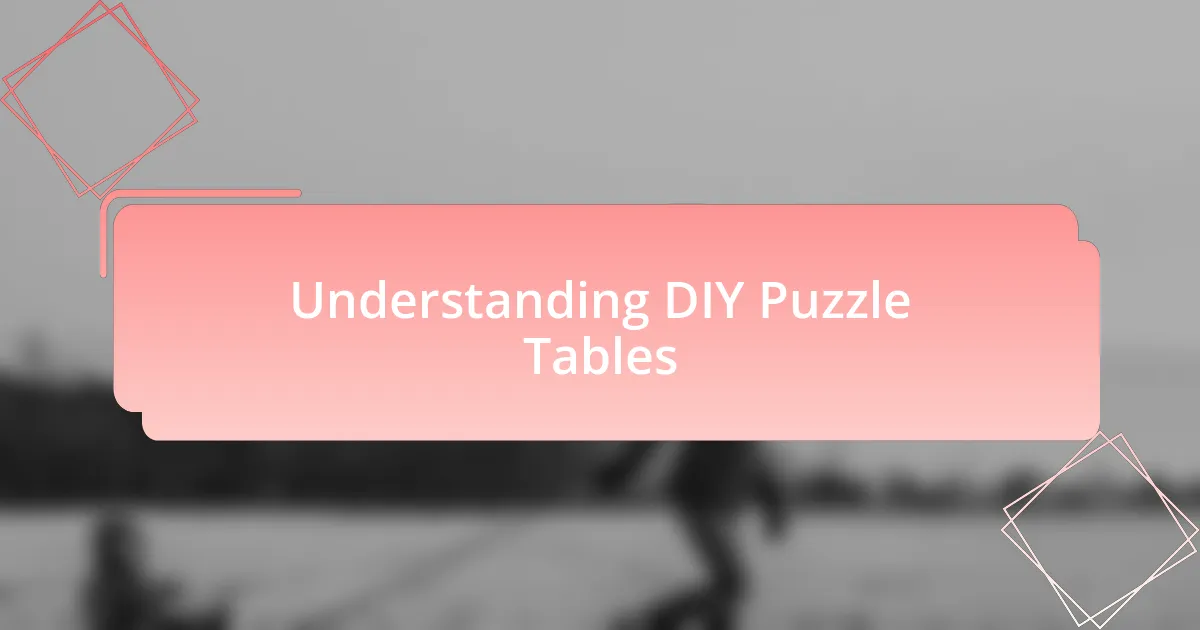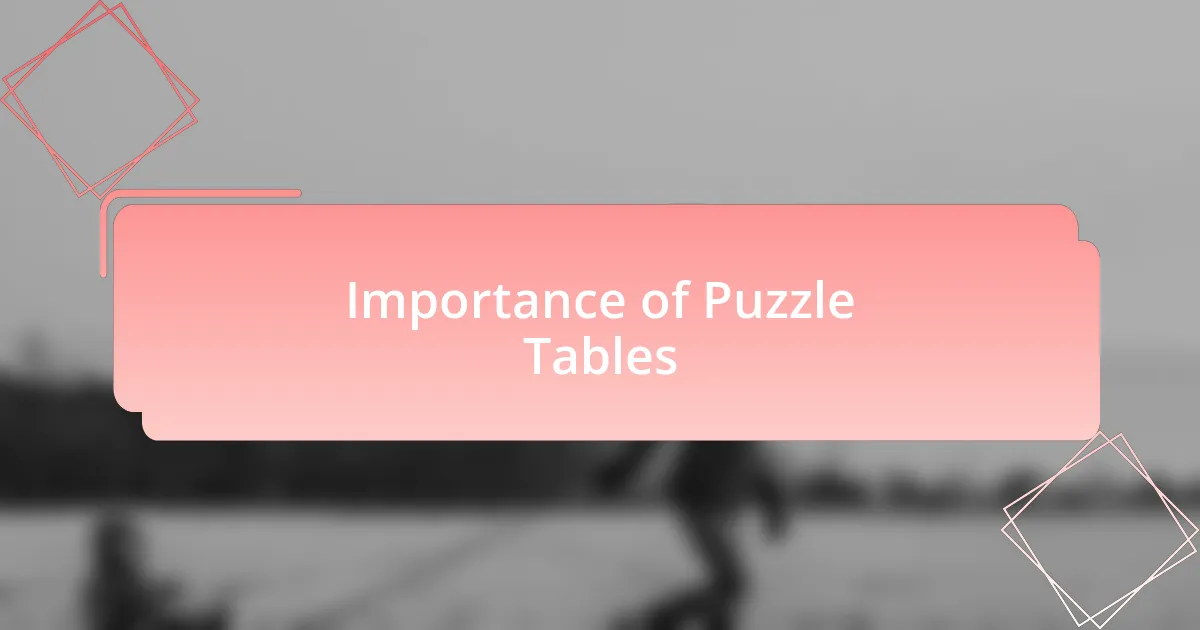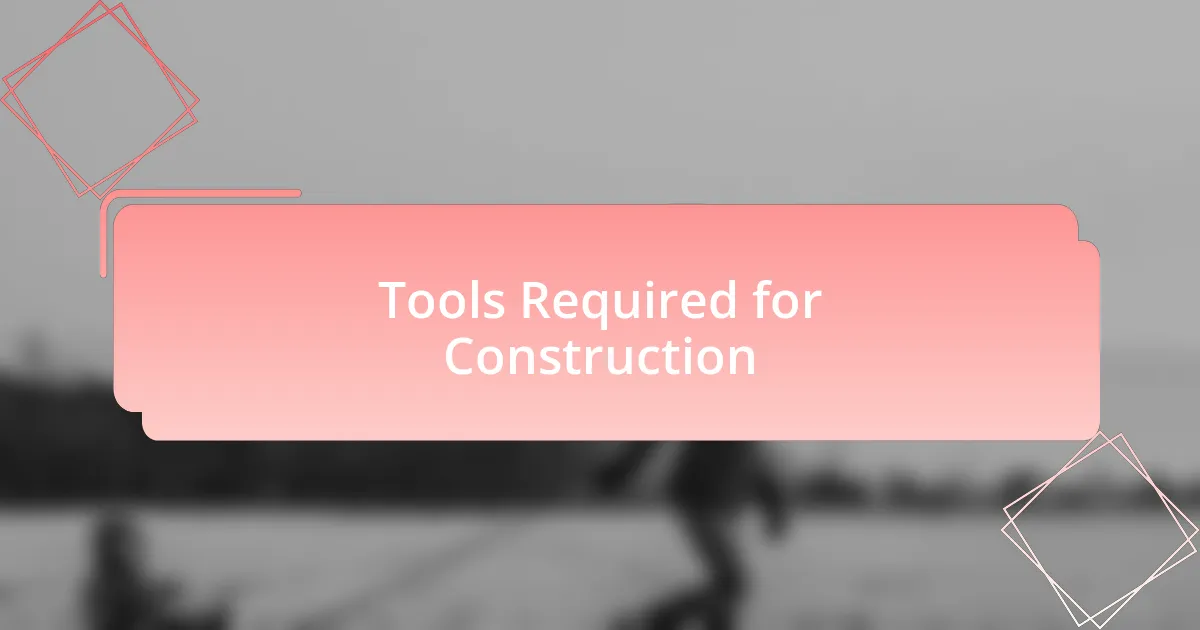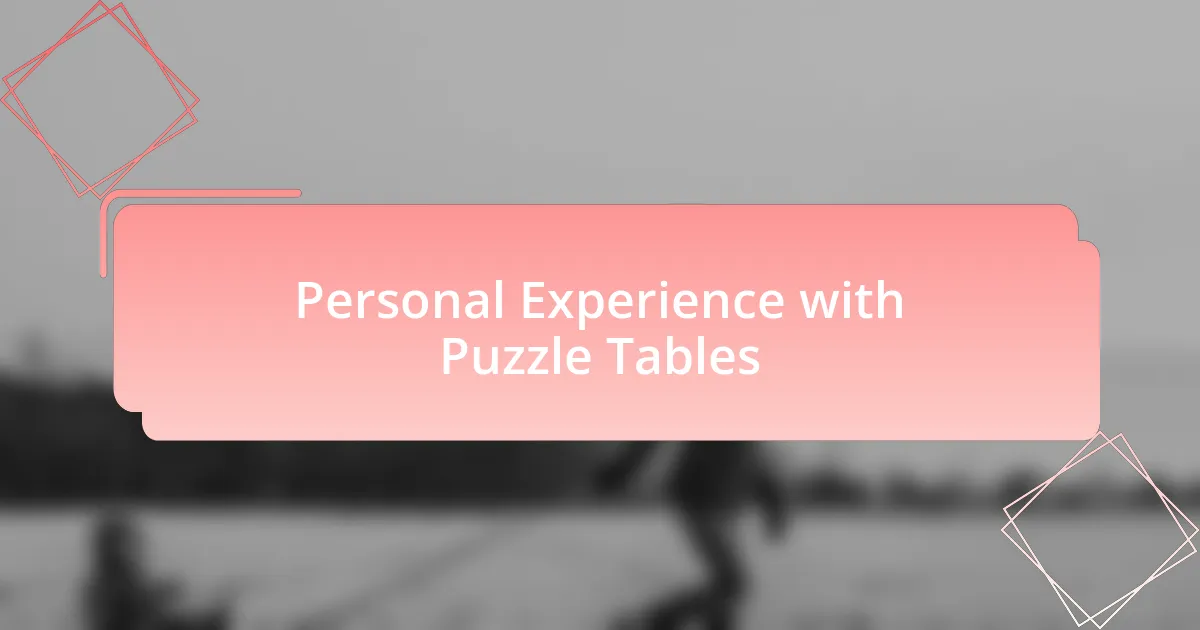Key takeaways:
- DIY puzzle tables provide a dedicated, personal space for puzzle enthusiasts, enhancing both functionality and aesthetics.
- Building a puzzle table fosters family connections, encourages mindfulness, and improves visual-spatial skills, especially in children.
- Essential materials include a durable tabletop, sturdy legs, and adhesive elements to ensure stability.
- Key tools for construction are a power drill, saw, and measuring tape, critical for precision and efficiency in assembly.

Understanding DIY Puzzle Tables
When I first stumbled upon the idea of a DIY puzzle table, I was genuinely surprised by how much joy this simple project could bring. Imagine crafting a dedicated space for your favorite pastime, where you can spread out puzzle pieces without feeling rushed or cramped. Isn’t that an inviting thought?
Building a puzzle table isn’t just about functionality; it’s about creating a lovely centerpiece for family gatherings or cozy evenings at home. I recall the sense of satisfaction I felt when I finally saw my completed table, its surface adorned with vibrant puzzle pieces, ready to be transformed into a masterpiece. Doesn’t it make you think about how we can enhance our hobbies with a little creativity?
A DIY puzzle table also becomes a canvas for personal expression. You can choose the wood type, stains, and finishes that resonate with your style, making it uniquely yours. Have you ever thought about how a customized piece can reflect your personality and bring warmth to your space? It’s truly fulfilling to see something I built becoming a beloved part of our family traditions.

Importance of Puzzle Tables
Puzzle tables hold a special place in many homes, offering not just a practical solution for enthusiasts, but also a way to foster connection. I find that when family or friends gather around such a table, it creates an unspoken bond, encouraging conversations and collaborations. Have you ever noticed how the simplest activities can lead to the most profound connections?
Moreover, the significance of a puzzle table goes beyond shared experiences; it also promotes mindfulness. Working on a puzzle can be a meditative process that allows the mind to unwind while engaging in a visually rewarding task. I often lose track of time when piecing together a challenging design, feeling a sense of calmness wash over me. Isn’t it remarkable how a collection of tiny pieces can lead to such a sense of tranquility?
Lastly, puzzle tables can enhance visual and spatial skills, especially in children. I remember observing my niece as she enthusiastically struggled with a 500-piece puzzle; the way she slowly pieced together the image was gratifying to watch. It not only trained her patience but also boosted her problem-solving abilities. How wonderful is it that a simple table can contribute to learning while also being a fun activity?

Materials Needed for Assembly
To assemble a DIY puzzle table, you’ll need some essential materials that will make your project both enjoyable and effective. Start with a solid tabletop – I often use plywood for its durability and ease of working with. If you plan to add a bit of flair, consider a piece of wood with a nice finish. This can really elevate the look of your table, don’t you think?
Next, you’ll require sturdy legs or a base to support your tabletop. I personally prefer using pre-made table legs, which save time and effort. But if you’re feeling adventurous, constructing your own legs from wood can lend a unique touch. Have you ever experienced the satisfaction of creating your own furniture? It’s a rewarding feeling!
Finally, don’t overlook the adhesive elements, like glue or screws, to secure everything in place. I’ve learned that a combination of wood glue and screws offers the best stability, ensuring your table withstands years of enthusiastic puzzling. As you gather your materials, think about how your unique choices will reflect your personal style and enhance your puzzling experiences with family and friends.

Tools Required for Construction
To tackle the construction of your DIY puzzle table, certain tools are non-negotiable. A trusty power drill tops my list, as it effortlessly makes the process quicker, especially when attaching the legs. I remember my first use of a power drill; it felt like unlocking a superpower! Have you ever noticed how much a good tool can change your perception of a task?
Next, a saw is essential for cutting your wood to the appropriate sizes. I often opt for a circular saw because it provides clean cuts in minimal time, leaving me with more energy to focus on the design itself. The sound of the saw cutting through the wood is almost music to my ears—it’s where the magic begins! I still recall the thrill of that first cut; it marked the transition from planning to actual building.
Don’t forget measuring tapes and squares; they are crucial for ensuring that everything aligns perfectly. I can’t stress enough how my project improved once I embraced the importance of accurate measurements. After a few initial missteps with misalignment, I learned that precision is key. Have you ever been caught in a DIY pickles situation from poor measuring? Trust me, investing in these tools pays off tenfold in the end.

Step by Step Assembly Guide

Step by Step Assembly Guide
To kick off your DIY puzzle table assembly, start by laying out all your materials in an organized manner. I remember when I first attempted a project without doing this; it turned into a chaotic hunt for screws and boards, leaving me frustrated. Have you ever experienced that moment where you spend more time searching than building? Keeping everything in its place streamlines the process and keeps your focus sharp.
Once you’ve laid everything out, begin by assembling the tabletop. Lay your boards side by side and use wood glue to bond them at the seams; this method is crucial for stability. I still recall the scent of the wood glue wafting through the air as I pressed those boards together, almost like sealing a pact with my DIY project. As it dries, take this moment to envision what your finished puzzle table will look like—dreams begin here!
Next, attach the legs to the tabletop. This step can be tricky, as the table needs to be level for perfect balance. I remember using wooden shims to ensure everything was straight; it was that “aha” moment that made me realize how important it is to level your work. Have you ever had a wobbly table? You’ll appreciate the extra time spent on leveling once your puzzle pieces fit neatly across a steady surface. Trust me, that final touch makes all the difference in usability and aesthetics.

Personal Experience with Puzzle Tables
There’s something truly special about puzzle tables that resonates with me. I vividly recall the countless weekends spent with my family gathered around a table, piecing together intricate designs. Those moments turned into a delightful ritual, filled with laughter, stories, and a sense of achievement as we completed each puzzle. Have you ever felt that satisfaction when the final piece falls into place? It’s a unique feeling, one that brings everyone closer together.
In my experience, a well-crafted puzzle table transforms the entire puzzle-solving process. I once struggled with finding a comfortable setup on my dining table. My back would ache from hunched positions, and my concentration would wane. When I switched to a dedicated puzzle table, everything changed. Suddenly, it wasn’t just about the puzzle; it became a comfortable, inviting space for creativity and conversation.
Another memory that stands out is when I customized my puzzle table, choosing colors and finishes that complemented my home. I felt an immense sense of pride each time a friend complimented my handiwork. It made me realize that crafting something with my own hands not only enhances functionality but also imbues it with personal meaning. Have you ever created something that holds a special place in your heart? For me, that table became more than just a furniture piece; it became a cherished family heirloom in the making.